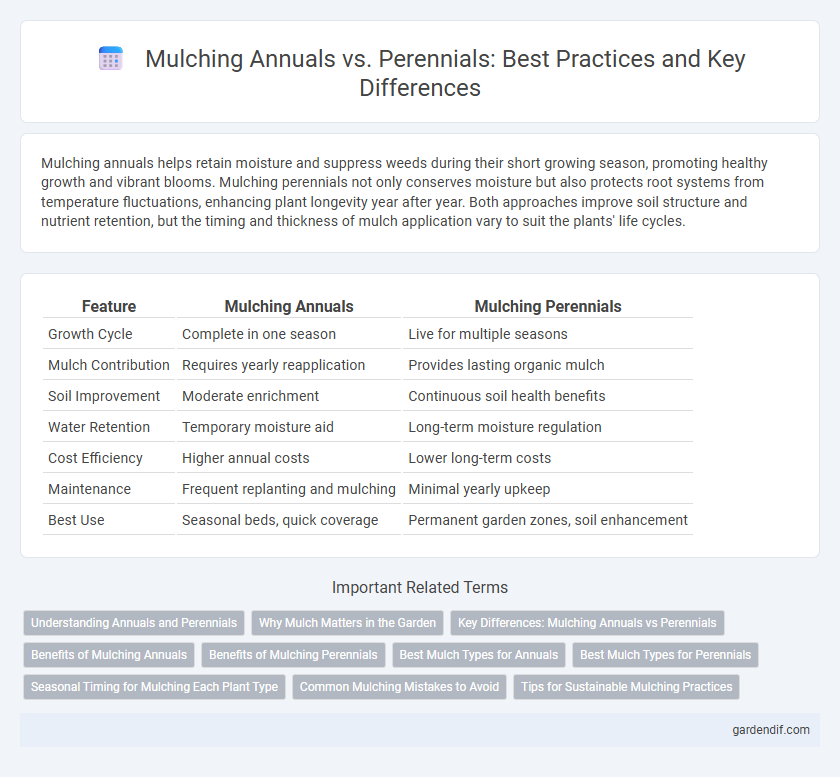
Mulching Annuals vs Mulching Perennials Illustration
Mulching annuals helps retain moisture and suppress weeds during their short growing season, promoting healthy growth and vibrant blooms. Mulching perennials not only conserves moisture but also protects root systems from temperature fluctuations, enhancing plant longevity year after year. Both approaches improve soil structure and nutrient retention, but the timing and thickness of mulch application vary to suit the plants' life cycles.
Table of Comparison
| Feature | Mulching Annuals | Mulching Perennials |
|---|---|---|
| Growth Cycle | Complete in one season | Live for multiple seasons |
| Mulch Contribution | Requires yearly reapplication | Provides lasting organic mulch |
| Soil Improvement | Moderate enrichment | Continuous soil health benefits |
| Water Retention | Temporary moisture aid | Long-term moisture regulation |
| Cost Efficiency | Higher annual costs | Lower long-term costs |
| Maintenance | Frequent replanting and mulching | Minimal yearly upkeep |
| Best Use | Seasonal beds, quick coverage | Permanent garden zones, soil enhancement |
Understanding Annuals and Perennials
Annuals complete their life cycle within one growing season, requiring mulching that protects fragile roots during rapid growth and frequent replanting. Perennials, living for multiple years, benefit from mulch that conserves moisture, suppresses weeds, and provides insulation against temperature fluctuations to support long-term root health. Understanding these growth patterns helps optimize mulching techniques, enhancing plant vigor and garden sustainability.
Why Mulch Matters in the Garden
Mulching annuals conserves moisture and suppresses weeds during their short growing season, promoting healthy growth and vibrant blooms. Perennial mulch improves soil structure and protects roots from extreme temperatures, enhancing plant longevity year after year. Consistent mulching reduces erosion and maintains soil nutrients, making it essential for sustainable garden health across both plant types.
Key Differences: Mulching Annuals vs Perennials
Mulching annuals requires frequent replenishment as these plants complete their life cycle within a single growing season, helping retain soil moisture and regulate temperature during rapid growth periods. Perennials benefit from thicker, more durable mulch layers that protect root systems through dormancy and varying seasonal conditions, improving soil structure over time. Key differences lie in mulch longevity and depth, with annuals needing lighter, more frequently replaced mulch, while perennials thrive under deeper, long-lasting mulch that supports their multi-year growth cycle.
Benefits of Mulching Annuals
Mulching annuals enhances soil moisture retention and temperature regulation, leading to healthier, more vigorous plants throughout their short growing season. It also suppresses weed growth effectively, reducing competition for nutrients and water. Moreover, mulch contributes to improved soil fertility by gradually decomposing and enriching the soil with organic matter essential for annual plant development.
Benefits of Mulching Perennials
Mulching perennials enhances soil moisture retention and temperature regulation, leading to healthier root systems and extended growing seasons. Organic mulch breaks down slowly, enriching the soil with vital nutrients year after year, which supports perennial longevity and resilience. This practice also suppresses perennial weed growth, reducing maintenance and promoting robust plant development.
Best Mulch Types for Annuals
Organic mulches such as shredded bark, straw, and composted leaves are ideal for annuals because they improve soil structure, retain moisture, and provide essential nutrients throughout the growing season. Inorganic options like black plastic mulch can also benefit annuals by warming the soil and reducing weed competition, but they do not enrich soil fertility. Selecting mulches that decompose relatively quickly supports the rapid growth cycle of annual plants by maintaining optimal soil conditions.
Best Mulch Types for Perennials
Organic mulches like shredded bark, compost, and pine needles are the best mulch types for perennials due to their ability to improve soil structure, retain moisture, and regulate temperature. Inorganic mulches, such as rubber or plastic, are less ideal for perennials because they do not decompose or enrich the soil over time. Applying a 2-4 inch layer of organic mulch around perennial plants enhances root health and encourages vigorous growth season after season.
Seasonal Timing for Mulching Each Plant Type
Mulching annuals is best done after planting in spring to regulate soil temperature and retain moisture during their growth cycle, while perennials benefit from mulching in late fall to protect roots from winter cold. Spring mulching prevents soil erosion and weed growth for annuals, ensuring a healthy growing season. For perennials, applying mulch later preserves root vitality by insulating against freeze-thaw cycles, enhancing plant survival and vigor in subsequent seasons.
Common Mulching Mistakes to Avoid
Applying mulch too thickly around annuals can lead to root rot and impaired growth, while perennials require a thinner layer to prevent stem rot and allow winter hardiness. Common mulching mistakes include using inappropriate mulch materials that retain excess moisture or fail to insulate properly, and piling mulch directly against plant stems, which invites pests and disease. Proper mulching techniques optimize soil moisture retention, temperature regulation, and protection for both annual and perennial plants.
Tips for Sustainable Mulching Practices
Mulching annuals requires frequent replenishment since these plants complete their life cycle in one season, making it essential to maintain a 2-3 inch layer of organic mulch such as shredded leaves or straw to regulate soil temperature and moisture. Perennials benefit from a thicker, more permanent mulch layer of 3-4 inches composed of bark or wood chips, which decomposes slowly, improving long-term soil fertility and structure. Sustainable mulching practices include avoiding mulch buildup against plant stems, using locally sourced materials to reduce carbon footprint, and monitoring soil moisture to prevent over-mulching and root rot.
Mulching Annuals vs Mulching Perennials Infographic

 gardendif.com
gardendif.com